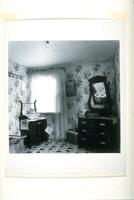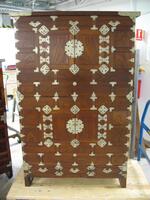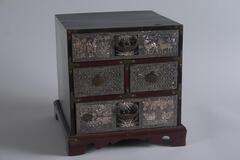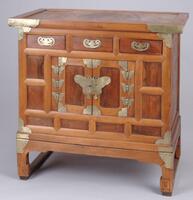6 UMMA Objects
6 UMMA Objects

Walker Evans (American (North American))
Bedroom, Fisherman's House, Nova Scotia
1971
Gift of Mr. and Mrs. Harry H. Lunn, Jr., in Honor of the Centennial of The Michigan Daily
1990/2.44

Korean (Korean (culture or style))
Chest (in three pieces)
1850 – 1950
Museum Purchase made possible by the Margaret Watson Parker Art Collection Fund
2009/2.25A-C

Korean (Korean (culture or style))
Comb Chest (Jage Bitjeup)
19th century
Gift of Bruce and Inta Hasenkamp and Museum purchase made possible by Elder and Mrs. Sang-Yong Nam
2004/1.314

Korean (Korean (culture or style))
Mouri jang (chest with 3 drawers and central double doors and butterfly brass fittings)
1833 – 1866
Gift of Bruce and Inta Hasenkamp and Museum purchase made possible by Elder and Mrs. Sang-Yong Nam
2004/1.311
![A large metal bar lock, similar to a u-bar lock fitted with a long key, meant to use as a lock for a chest.<br />
<br />
The shape and structure of this lock conform to those of the conventional “ㄷ”-shaped type of lock. However, its round body resembles the shape of a pipe when viewed from the side. This type of lock was most frequently used for locking small chests and boxes. It was made by forging and soldering iron. The tip of the key resembles the letter “T” in shape, standing at an angle perpendicular to the handle.
<p>[Korean Collection, University of Michigan Museum of Art (2017), 245]</p>
A large metal bar lock, similar to a u-bar lock fitted with a long key, meant to use as a lock for a chest.<br />
<br />
The shape and structure of this lock conform to those of the conventional “ㄷ”-shaped type of lock. However, its round body resembles the shape of a pipe when viewed from the side. This type of lock was most frequently used for locking small chests and boxes. It was made by forging and soldering iron. The tip of the key resembles the letter “T” in shape, standing at an angle perpendicular to the handle.
<p>[Korean Collection, University of Michigan Museum of Art (2017), 245]</p>](/media/W1siZiIsIjIwMjIvMDkvMjQvNmRrbGk4azhia19kZWZhdWx0LmpwZyJdLFsicCIsInRodW1iIiwiMjQweDIwMCJdXQ?sha=e765608ba4f2f539)
Korean (Korean (culture or style))
Lock for Chest
1850 – 1950
Gift of Ok Ja Chang and the Chang Family
2009/2.57
Loading…

